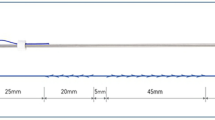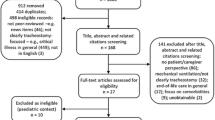Abstract
Purpose
To determine the clinical efficacy and safety of growth factors in the treatment of tympanic membrane (TM) perforations from randomized controlled trials (RCTs).
Methods
Databases, including PubMed, EMBASE, Cochrane library, Ebsco, Ovid, Scopus, and Web of Science, were searched for articles in any language about studies on the treatment of TM perforations with growth factors. Inclusion criteria were: (1) randomized controlled trials (RCTs); (2) only patients with TM perforations included; and (3) any kinds of growth factors or related products were used as an intervention. Exclusion criteria were: (1) study was not reported as a full paper, only as an abstract; (2) review studies and case reports; and (3) an inability to extract valid data. Outcomes of interest included perforation closure rate, closure time, hearing improvement, and complications.
Results
Nineteen RCTs with a total of 1335 participants were included. Growth factors effectively increased the rate of perforation closure [risk ratio (RR): 1.21 95% confidence interval (1.12, 1.30), p < 0.01] and shortened closure time [mean difference (MD): − 16.71 (− 22.74, − 10.15), p < 0.01]. There was no significant difference in hearing improvement [MD: 0.10 (− 0.50, 0.70), p = 0.74] or complications [RR: 1.49 (0.96, 2.32), p = 0.07] between the growth factor intervention group and the control group.
Conclusion
Growth factors are effective and safe in the treatment of TM perforations. However, better designed clinical trials should be carried out in the future to obtain more robust findings about the effectiveness of growth factors in the treatment of TM perforations.





Similar content being viewed by others
References
Seonwoo H, Shin B, Jang KJ, Lee M, Choo OS, Park SB et al (2019) Epidermal growth factor-releasing radially aligned electrospun nanofibrous patches for the regeneration of chronic tympanic membrane perforations. Adv Healthc Mater 8(2):e1801160. https://doi.org/10.1002/adhm.201801160
Visvanathan V, Vallamkondu V, Bhimrao SK (2018) Achieving a successful closure of an anterior tympanic membrane perforation: evidence-based systematic review. Otolaryngol Head Neck Surg Off J Am Acad Otolaryngol Head Neck Surg. 158(6):1011–1015. https://doi.org/10.1177/0194599818764335
Park MK, Kim KH, Lee JD, Lee BD (2011) Repair of large traumatic tympanic membrane perforation with a Steri-Strips patch. Otolaryngol Head Neck Surg Off J Am Acad Otolaryngol Head Neck Surgery. 145(4):581–585. https://doi.org/10.1177/0194599811409836
Hong P, Bance M, Gratzer PF (2013) Repair of tympanic membrane perforation using novel adjuvant therapies: a contemporary review of experimental and tissue engineering studies. Int J Pediatr Otorhinolaryngol 77(1):3–12. https://doi.org/10.1016/j.ijporl.2012.09.022
Lott DG, Janus JR (2014) Tissue engineering for otorhinolaryngology-head and neck surgery. Mayo Clin Proc 89(12):1722–1733. https://doi.org/10.1016/j.mayocp.2014.09.007
Yao X, Teh BM, Li H, Hu Y, Huang J, Lv C et al (2020) Acellular collagen scaffold with basic fibroblast growth factor for repair of traumatic tympanic membrane perforation in a rat model. Otolaryngol Head Neck Surg Off JAm Acad Otolaryngol Head Neck Surg. https://doi.org/10.1177/0194599820938345
Seonwoo H, Kim SW, Kim J, Chunjie T, Lim KT, Kim YJ et al (2013) Regeneration of chronic tympanic membrane perforation using an EGF-releasing chitosan patch. Tissue Eng Part A 19(17–18):2097–2107. https://doi.org/10.1089/ten.TEA.2012.0617
Lou Z (2019) The effect of epidermal growth factor on the pseudo-healing of traumatic tympanic membrane perforations. Braz J Otorhinolaryngol. https://doi.org/10.1016/j.bjorl.2019.06.011
Hakuba N, Iwanaga M, Tanaka S, Hiratsuka Y, Kumabe Y, Konishi M et al (2010) Basic fibroblast growth factor combined with atelocollagen for closing chronic tympanic membrane perforations in 87 patients. Otol Neurotol 31(1):118–121. https://doi.org/10.1097/MAO.0b013e3181c34f01
Acharya AN, Coates H, Tavora-Vièira D, Rajan GP (2015) A pilot study investigating basic fibroblast growth factor for the repair of chronic tympanic membrane perforations in pediatric patients. Int J Pediatr Otorhinolaryngol 79(3):332–335. https://doi.org/10.1016/j.ijporl.2014.12.014
Fouad YA, Abdelhady M, El-Anwar M, Merwad E (2018) Topical platelet rich plasma versus hyaluronic acid during fat graft myringoplasty. Am J Otolaryngol 39(6):741–745. https://doi.org/10.1016/j.amjoto.2018.08.004
Huang JT, Teh BM, Eikelboom RH, Han LY, Xu GD, Yao X et al (2020) The effectiveness of bFGF in the treatment of tympanic membrane perforations: a systematic review and meta-analysis. Otol Neurotol 41(6):782–790. https://doi.org/10.1097/mao.0000000000002628
Moher D, Shamseer L, Clarke M, Ghersi D, Liberati A, Petticrew M et al (2015) Preferred reporting items for systematic review and meta-analysis protocols (PRISMA-P) 2015 statement. Syst Rev 4:1. https://doi.org/10.1186/2046-4053-4-1
Hakuba N, Taniguchi M, Shimizu Y, Sugimoto A, Shinomori Y, Gyo K (2003) A new method for closing tympanic membrane perforations using basic fibroblast growth factor. Laryngoscope 113(8):1352–1355. https://doi.org/10.1097/00005537-200308000-00016
Kanemaru S, Kanai R, Yoshida M, Kitada Y, Omae K, Hirano S (2018) Application of regenerative treatment for tympanic membrane perforation with cholesteatoma, tumor, or severe calcification. Otol Neurotol 39(4):438–444. https://doi.org/10.1097/mao.0000000000001701
Lou Z, Xu L, Yang J, Wu X (2011) Outcome of children with edge-everted traumatic tympanic membrane perforations following spontaneous healing versus fibroblast growth factor-containing gelfoam patching with or without edge repair. Int J Pediatr Otorhinolaryngol 75(10):1285–1288. https://doi.org/10.1016/j.ijporl.2011.07.012
Lou ZC (2019) Dose- and starting time-dependent effect of the application of EGF to the regeneration of traumatic eardrum. Acta Otolaryngol 139(12):1083–1089. https://doi.org/10.1080/00016489.2019.1667533
Lou Z, Wang Y, Yu G (2014) Effects of basic fibroblast growth factor dose on traumatic tympanic membrane perforation. Growth Factors (Chur, Switzerland) 32(5):150–154. https://doi.org/10.3109/08977194.2014.952411
Kanemaru SI, Kanai R (2016) Regenerative treatment for tympanic membrane perforation with cholesteatoma, tumor, or severe calcification. J Laryngol Otol 130:S186. https://doi.org/10.1017/S0022215116005855
Lou Z (2016) A comparative study evaluating the utility of EGF, FGF-2, and ofloxacin drops on eardrum regeneration. J Laryngol Otol 130:S105. https://doi.org/10.1017/S0022215116003935
Djamin R, Aziza R, Rahardjo SP, Savitri E, Punagi AQ, Patellongi IJ et al (2018) Topical application of epidermal growth factor (EGF) to changes in tympanic membrane perforation diameter. J Med Sci (Faisalabad) 18(4):186–191. https://doi.org/10.3923/jms.2018.186.191
Habesoglu M, Oysu C, Sahin S, Sahin-Yilmaz A, Korkmaz D, Tosun A et al (2014) Platelet-rich fibrin plays a role on healing of acute-traumatic ear drum perforation. J Craniofac Surg 25(6):2056–2058. https://doi.org/10.1097/scs.0000000000001140
Jin ZH, Dong YH, Lou ZH (2017) The effects of fibroblast growth factor-2 delivered via a Gelfoam patch on the regeneration of myringosclerotic traumatic eardrum perforations lying close to the malleus. Am J Otolaryngol 38(5):582–587. https://doi.org/10.1016/j.amjoto.2017.06.005
Kanemaru S, Umeda H, Kitani Y, Nakamura T, Hirano S, Ito J (2011) Regenerative treatment for tympanic membrane perforation. Otol Neurotol Off Publ Am Otol Soc Am Neurotol Soc Eur Acad Otol Neurotol. 32(8):1218–1223. https://doi.org/10.1097/MAO.0b013e31822e0e53
Lou Z, Huang P, Yang J, Xiao J, Chang J (2016) Direct application of bFGF without edge trimming on human subacute tympanic membrane perforation. Am J Otolaryngol 37(2):156–161. https://doi.org/10.1016/j.amjoto.2015.11.004
Lou Z, Lou Z (2017) A comparative study to evaluate the efficacy of EGF, FGF-2, and 0.3% (w/v) ofloxacin drops on eardrum regeneration. Medicine 96(30):e7654. https://doi.org/10.1097/MD.0000000000007654
Lou Z, Wang Y (2015) Evaluation of the optimum time for direct application of fibroblast growth factor to human traumatic tympanic membrane perforations. Growth factors (Chur, Switzerland) 33(2):65–70. https://doi.org/10.3109/08977194.2014.980905
Lou ZC, Lou Z (2018) Efficacy of EGF and gelatin sponge for traumatic tympanic membrane perforations: a randomized controlled study. Otolaryngol Head Neck Surg Off J Am Acad Otolaryngol Head Neck Surg. 159(6):1028–1036. https://doi.org/10.1177/0194599818792019
Lou ZC, Lou ZH, Liu YC, Chang J (2016) Healing human moderate and large traumatic tympanic membrane perforations using basic fibroblast growth factor, 0.3% ofloxacin eardrops, and gelfoam patching. Otol Neurotol 37(6):735–741
Lou ZC, Wang YB (2013) Healing outcomes of large (>50%) traumatic membrane perforations with inverted edges following no intervention, edge approximation and fibroblast growth factor application; a sequential allocation, three-armed trial. Clin Otolaryngol 38(4):289–296. https://doi.org/10.1111/coa.12135
Lou ZC, Yang J, Tang Y, Fu YH (2016) Topical application of epidermal growth factor with no scaffold material on the healing of human traumatic tympanic membrane perforations. Clin Otolaryngol 41(6):744–749. https://doi.org/10.1111/coa.12627
Lou Z-C, Dong Y, Lou Z-H (2019) Comparative study of epidermal growth factor and observation only on human subacute tympanic membrane perforation. Am J Otolaryngol 40(2):209–212. https://doi.org/10.1016/j.amjoto.2018.11.011
Mekhemar SM, Moustafa SY, Aaty E, Kholy TAE, Ahmed YS (2020) Efficacy of topical use of autologous platelet rich plasma in myringoplasty. Egypt J Hosp Med 78(2):326–331
Ramsay HA, Heikkonen EJ, Laurila PK (1995) Effect of epidermal growth factor on tympanic membranes with chronic perforations: a clinical trial. Otolaryngol Head Neck Surg 113(4):375–379. https://doi.org/10.1016/s0194-5998(95)70071-4
Roosli C, von Buren T, Gassmann NB, Huber AM (2011) The impact of platelet-derived growth factor on closure of chronic tympanic membrane perforations: a randomized, double-blind, placebo-controlled study. Otol Neurotol 32(8):1224–1229. https://doi.org/10.1097/MAO.0b013e31822e96bc
Sankaranarayanan G, Prithiviraj V, Kumar RV (2013) A study on efficacy of autologous platelet rich plasma in myringoplasty. Online J Otolaryngol 3(3):1–15
Santos F, Shu E, Lee DJ, Jung DH, Quesnel A, Stankovic K et al (2020) Topical fibroblast growth factor-2 for treatment of chronic tympanic membrane perforations. Laryngosc Investig Otolaryngol. https://doi.org/10.1002/lio2.395
Zhang Q, Lou Z (2012) Impact of basic fibroblast growth factor on healing of tympanic membrane perforations due to direct penetrating trauma: a prospective non-blinded/controlled study. Clin Otolaryngol 37(6):446–451. https://doi.org/10.1111/coa.12017
Zheng L, Zi-Han L (2018) The short- and long-term adverse effects of FGF-2 on tympanic membrane perforations. Acta Otorhinolaryngol Ital 38(3):264–272. https://doi.org/10.14639/0392-100x-1480
Zheng L, Zihan L, Yongmei T (2016) Comparative study on the effects of EGF and bFGF on the healing of human large traumatic perforations of the tympanic membrane. Laryngoscope 126(1):E23–E28. https://doi.org/10.1002/lary.25715
Lou ZC, Lou ZH, Xiao J (2018) Regeneration of the tympanic membrane using fibroblast growth factor-2. J Laryngol Otol 132(6):470–478. https://doi.org/10.1017/s002221511800083x
Linstrom CJ, Silverman CA, Rosen A, Meiteles LZ (2001) Bone conduction impairment in chronic ear disease. Ann Otol Rhinol Laryngol 110(5 Pt 1):437–441. https://doi.org/10.1177/000348940111000508
Tuz M, Dogru H, Uygur K, Gedikli O (2000) Improvement in bone conduction threshold after tympanoplasty. Otolaryngol Head Neck Surg Off J Am Acad Otolaryngol Head Neck Surg. 123(6):775–778. https://doi.org/10.1067/mhn.2000.111292
Omae K, Kanemaru S, Nakatani E, Kaneda H, Nishimura T, Tona R et al (2017) Regenerative treatment for tympanic membrane perforation using gelatin sponge with basic fibroblast growth factor. Auris Nasus Larynx 44(6):664–671. https://doi.org/10.1016/j.anl.2016.12.005
Hakuba N, Ikemune K, Okada M, Hato N (2015) Use of ambulatory anesthesia with manually assisted ventilation for tympanic membrane regeneration therapy in children. Am J Otolaryngol 36(2):153–157. https://doi.org/10.1016/j.amjoto.2014.10.012
Kalicke T, Koller M, Frangen TM, Schlegel U, Sprutacz O, Printzen G et al (2007) Local application of basic fibroblast growth factor increases the risk of local infection after trauma: an in-vitro and in-vivo study in rats. Acta Orthop 78(1):63–73. https://doi.org/10.1080/17453670610013439
Mondain M, Ryan A (1994) Effect of basic fibroblast growth factor on normal tympanic membrane. Am J Otolaryngol 15(5):344–350. https://doi.org/10.1016/0196-0709(94)90133-3
Friedman NR, Wright CG, Pawlowski KS, Meyerhoff WL (1997) Effect of basic fibroblast growth factor on perforated chinchilla tympanic membranes. Ear Nose Throat J 76(8):559–564
Author information
Authors and Affiliations
Corresponding author
Ethics declarations
Conflict of interest
The authors declare no conflicts of interest.
Additional information
Publisher's Note
Springer Nature remains neutral with regard to jurisdictional claims in published maps and institutional affiliations.
Supplementary Information
Below is the link to the electronic supplementary material.
405_2021_6891_MOESM4_ESM.pdf
Online Resource 4. Galbraith plots of outcomes with heterogeneity. Pooled outcome of perforation closure rate (A), perforation closure rate of FGF subgroup analysis (B), perforation closure rate of PDGF subgroup analysis (C), pooled outcome of closure time (D), closure time of FGF subgroup analysis (E), and closure time of EGF subgroup analysis (F)file4 (PDF 553 KB)
Rights and permissions
About this article
Cite this article
Xu, S., Yu, J., Hu, Y. et al. The effectiveness and safety of growth factors in the treatment of tympanic membrane perforations: a systematic review and meta-analysis of randomized controlled trials. Eur Arch Otorhinolaryngol 279, 1863–1874 (2022). https://doi.org/10.1007/s00405-021-06891-6
Received:
Accepted:
Published:
Issue Date:
DOI: https://doi.org/10.1007/s00405-021-06891-6




